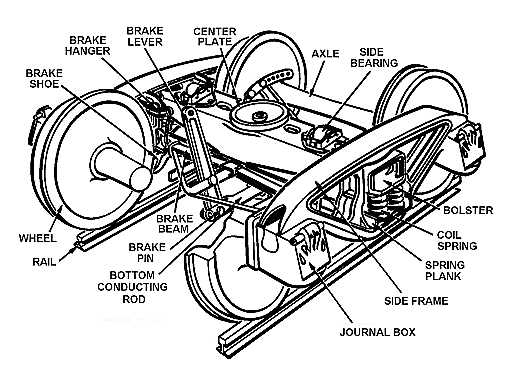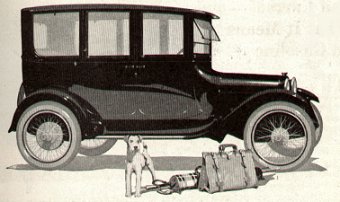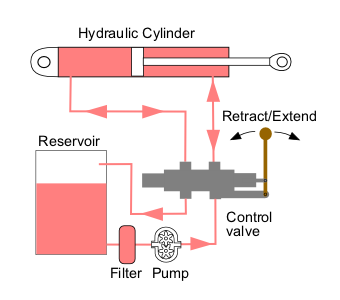|
Decelostat
Decelostat is a wheel slide protection system developed by Westinghouse Air Brake Company that is used in railroad cars to prevent over-braking that causes wheel-slide, a condition of reduction in friction between train wheels and rails. This low wheel/rail adhesion condition reduces braking performance and causes damage to wheels (wheel spalling and wheel flat) and the rails. When over-braking, the Decelostat will detect rapid deceleration of wheel rotation caused by creep in the wheelset, another condition preceding the wheel-slide. Once detected, the system manipulates brake valves to reduce brake pressure. This allows the affected wheels to rotate at the speeds that are more comparable to the speeds of the train to gain the wheel/rail adhesion again. When that happens, the system deactivates to allow the brake pressure to be restored to continue braking. The system may reactivate again if it detects another creep. The cycle of activation and deactivation is usually brief bu ... [...More Info...] [...Related Items...] OR: [Wikipedia] [Google] [Baidu] |
Wheel Slide Protection
Wheel slide protection and wheel slip protection are railway terms used to describe automatic systems used to detect and prevent wheel-slide during braking or wheel-slip during acceleration. This is analogous to ABS and traction control systems used on motor vehicles. It is particularly important in slippery rail conditions. Sanding Sanding is one method of reducing wheel slip or slide. Locomotives and Multiple units have sandboxes which can deliver dry sand to the rails in front of the wheels. This may be initiated automatically when the Wheel Slide Protection system senses loss of adhesion, or the driver can operate it manually. Sanding may be connected to a computer system that determines the train's direction and where the sand should be applied: either forward or aft of the trucks. In older locomotives there was a manual lever attached to a valve that had three positions: Off, Forward, and Aft. Automatic control systems Wheel Slide Protection (WSP) equipment is general ... [...More Info...] [...Related Items...] OR: [Wikipedia] [Google] [Baidu] |
Westinghouse Air Brake Company
The Westinghouse Air Brake Company (sometimes nicknamed or abbreviated WABCO although this was also confusingly used for spinoffs) was founded on September 28, 1869 by George Westinghouse in Pittsburgh, Pennsylvania. Earlier in the year he had invented the railway air brake in New York state. After having manufactured equipment in Pittsburgh for a number of years, he began to construct facilities and plants east of the city where homes for his employees were built. In 1889, the air brake manufacturing facility was moved to Wilmerding, Pennsylvania, and the company's general office building was built there in 1890. In 1921 the company began manufacturing a modified air brake system for installation in trucks and heavy vehicles. In 1953 WABCO entered the heavy equipment marketplace, buying the assets of leading equipment designer R.G LeTourneau. An entity known as LeTourneau-Westinghouse sold a range of innovative products, including scrapers, cranes and bulldozers until 19 ... [...More Info...] [...Related Items...] OR: [Wikipedia] [Google] [Baidu] |
Axlebox
A bogie or railroad truck holds the wheel sets of a rail vehicle. Axlebox An ''axle box'', also known as a ''journal box'' in North America, is the mechanical subassembly on each end of the axles under a railway wagon, coach or locomotive; it contains bearings and thus transfers the wagon, coach or locomotive weight to the wheels and rails; the bearing design is typically oil-bathed plain bearings on older rolling stock, or roller bearings on newer rolling stock. Plain bearings are now illegal for interchange service in North America. As early as 1908 axle boxes contained a set of long cylindrical rollers allowing the axle to rotate. It was also used on steam locomotives such as the Victorian Railways A2 class, the LMS Garratt, the LSWR 415 class, and the GCR Class 1. Center pin A large steel pin—or rod—which passes through the center plates on the body bolster and truck bolster. The truck turns about the pin, and stress is taken by the center plates. Cente ... [...More Info...] [...Related Items...] OR: [Wikipedia] [Google] [Baidu] |
Budd Company
The Budd Company was a 20th-century metal fabricator, a major supplier of body components to the automobile industry, and a manufacturer of stainless steel passenger rail cars, airframes, missile and space vehicles, and various defense products. Budd was founded in 1912 in Philadelphia by Edward G. Budd, whose fame came from his development of the first all-steel automobile bodies in 1913, and his company's invention of the "shotweld" technique for joining pieces of stainless steel without damaging its anti-corrosion properties in the 1930s. Budd Company became part of Budd Thyssen in 1978, and in 1999 a part of ThyssenKrupp Budd. Body and chassis operations were sold to Martinrea International in 2006. No longer an operating company, Budd filed for bankruptcy in 2014. It currently exists to provide benefits to its retirees. Automobiles Edward G Budd developed the first all-steel automobile bodies. His first major supporters were the Dodge brothers. Following discussions ... [...More Info...] [...Related Items...] OR: [Wikipedia] [Google] [Baidu] |
Big Three (automobile Manufacturers)
In the automotive industry, the term Big Three is used for a country's three largest motor vehicle manufacturers, especially indicating companies that sell under multiple brand names. The term originated in the United States, where General Motors was the first to form a large, multi-brand, motor-vehicle corporation (in the 1910s), followed by Ford Motor Company, and the Chrysler Corporation, all before World War II. The term "Big Three" has since been sometimes used to refer to the following automakers: * Germany — the Volkswagen Group, the Mercedes-Benz Group, and BMW. * Japan — Toyota, Nissan, and Honda. * United States — Ford, General Motors, and Stellantis United States General Motors, Ford Motor Company, and Chrysler Stellantis North America are often referred to as the "Big Three", being the largest automakers in the United States. They were for a while the three largest in the world, with GM and Ford remaining as mainstays in the top five. The Big Th ... [...More Info...] [...Related Items...] OR: [Wikipedia] [Google] [Baidu] |
Popular Science
''Popular Science'' (also known as ''PopSci'') is an American digital magazine carrying popular science content, which refers to articles for the general reader on science and technology subjects. ''Popular Science'' has won over 58 awards, including the American Society of Magazine Editors awards for its journalistic excellence in 2003 (for General Excellence), 2004 (for Best Magazine Section), and 2019 (for Single-Topic Issue). With roots beginning in 1872, ''Popular Science'' has been translated into over 30 languages and is distributed to at least 45 countries. Early history '' The Popular Science Monthly'', as the publication was originally called, was founded in May 1872 by Edward L. Youmans to disseminate scientific knowledge to the educated layman. Youmans had previously worked as an editor for the weekly ''Appleton's Journal'' and persuaded them to publish his new journal. Early issues were mostly reprints of English periodicals. The journal became an outlet for writin ... [...More Info...] [...Related Items...] OR: [Wikipedia] [Google] [Baidu] |
Military Transport Aircraft
A military transport aircraft, military cargo aircraft or airlifter is a military-owned transport aircraft used to support military operations by airlifting troops and military equipment. Transport aircraft are crucial to maintaining supply lines to forward bases that are difficult to reach by ground or waterborne access, and can be used for both strategic and tactical missions. They are also often used for civilian emergency relief missions by transporting humanitarian aid. Air frames Fixed-wing Fixed-wing transport aeroplanes are defined in terms of their range capability as strategic airlift or tactical airlift to reflect the needs of the land forces which they most often support. These roughly correspond to the commercial flight length distinctions: Eurocontrol defines short-haul routes as shorter than , long-haul routes as longer than and medium-haul between. The military glider is an unpowered tactical air transport which has been used in some campaigns to t ... [...More Info...] [...Related Items...] OR: [Wikipedia] [Google] [Baidu] |
Piston Valve
A "piston valve" is a device used to control the motion of a fluid along a tube or pipe by means of the linear motion of a piston within a chamber or cylinder. Examples of piston valves are: * The valves used in many brass instruments * The valves used in pneumatic cannons * The valves used in many stationary steam engines and steam locomotives Brass instruments Cylindrical piston valves called Périnet valves (after their inventor François Périnet) are used to change the length of tube in the playing of most brass instruments, particularly the trumpet-like members of the family ( cornet, flugelhorn, saxhorn, etc.). Other brass instruments use rotary valves, notably the orchestral horns and many tuba The tuba (; ) is the lowest-pitched musical instrument in the brass instrument, brass family. As with all brass instruments, the sound is produced by lip vibrationa buzzinto a mouthpiece (brass), mouthpiece. It first appeared in the mid-19th&n ... models, but also ... [...More Info...] [...Related Items...] OR: [Wikipedia] [Google] [Baidu] |
Hydraulic Machinery
Hydraulic machines use liquid fluid power to perform work. Heavy construction vehicles are a common example. In this type of machine, hydraulic fluid is pumped to various hydraulic motors and hydraulic cylinders throughout the machine and becomes pressurized according to the resistance present. The fluid is controlled directly or automatically by control valves and distributed through hoses, tubes, or pipes. Hydraulic systems, like pneumatic systems, are based on Pascal's law which states that any pressure applied to a fluid inside a closed system will transmit that pressure equally everywhere and in all directions. A hydraulic system uses an incompressible liquid as its fluid, rather than a compressible gas. The popularity of hydraulic machinery is due to the very large amount of power that can be transferred through small tubes and flexible hoses, the high power density and a wide array of actuators that can make use of this power, and the huge multiplication of fo ... [...More Info...] [...Related Items...] OR: [Wikipedia] [Google] [Baidu] |
Pneumatic
Pneumatics (from Greek ‘wind, breath’) is a branch of engineering that makes use of gas or pressurized air. Pneumatic systems used in industry are commonly powered by compressed air or compressed inert gases. A centrally located and electrically-powered compressor powers cylinders, air motors, pneumatic actuators, and other pneumatic devices. A pneumatic system controlled through manual or automatic solenoid valves is selected when it provides a lower cost, more flexible, or safer alternative to electric motors, and hydraulic actuators. Pneumatics also has applications in dentistry, construction, mining, and other areas. Gases used in pneumatic systems Pneumatic systems in fixed installations, such as factories, use compressed air because a sustainable supply can be made by compressing atmospheric air. The air usually has moisture removed, and a small quantity of oil is added at the compressor to prevent corrosion and lubricate mechanical components. Factory-plumbed ... [...More Info...] [...Related Items...] OR: [Wikipedia] [Google] [Baidu] |
Landing Gear
Landing gear is the undercarriage of an aircraft or spacecraft that is used for takeoff or landing. For aircraft it is generally needed for both. It was also formerly called ''alighting gear'' by some manufacturers, such as the Glenn L. Martin Company. For aircraft, Stinton makes the terminology distinction ''undercarriage (British) = landing gear (US)''. For aircraft, the landing gear supports the craft when it is not flying, allowing it to take off, land, and taxi without damage. Wheeled landing gear is the most common, with skis or floats needed to operate from snow/ice/water and skids for vertical operation on land. Faster aircraft have retractable undercarriages, which fold away during flight to reduce drag. Some unusual landing gear have been evaluated experimentally. These include: no landing gear (to save weight), made possible by operating from a catapult cradle and flexible landing deck: air cushion (to enable operation over a wide range of ground obstacles and wa ... [...More Info...] [...Related Items...] OR: [Wikipedia] [Google] [Baidu] |
Actuator
An actuator is a component of a machine that is responsible for moving and controlling a mechanism or system, for example by opening a valve. In simple terms, it is a "mover". An actuator requires a control device (controlled by control signal) and a source of energy. The control signal is relatively low energy and may be electric voltage or current, pneumatic, or hydraulic fluid pressure, or even human power. Its main energy source may be an electric current, hydraulic pressure, or pneumatic pressure. The Control device is usually a valve. When it receives a control signal, an actuator responds by converting the source's energy into mechanical motion. In the ''electric'', ''hydraulic'', and ''pneumatic'' sense, it is a form of automation or automatic control. History The history of the pneumatic actuation system and the hydraulic actuation system dates to around the time of World War II (1938). It was first created by Xhiter Anckeleman who used his knowledge of engines an ... [...More Info...] [...Related Items...] OR: [Wikipedia] [Google] [Baidu] |



_-_ASCOT482.jpg)


